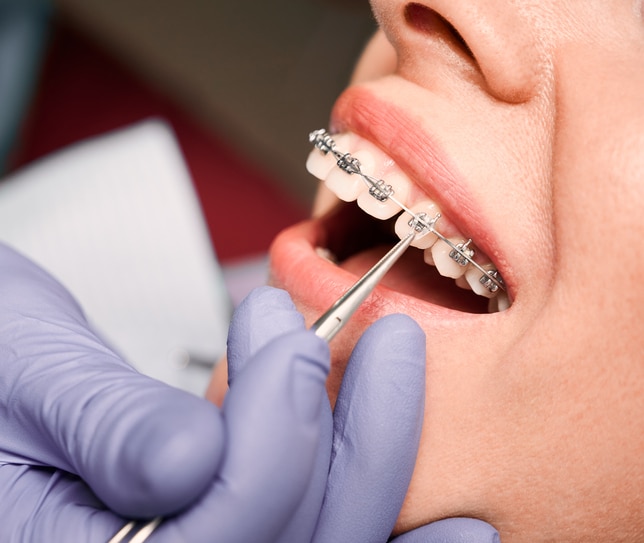Finding the Right Cumming Orthodontist for Your Braces and Aligners Requirements
Wiki Article
Comprehensive Overview to Orthodontics Treatments for Dealing With Dental Imbalances
In the world of orthodontics, the journey to accomplishing a perfectly straightened smile entails a myriad of treatments customized to deal with dental imbalances. From traditional dental braces to unnoticeable aligners and also medical options, the area of orthodontics supplies an array of services to address varying degrees of oral abnormalities. Understanding the details of each treatment, including their mechanisms, advantages, and possible disadvantages, is critical in making informed decisions about one's orthodontic treatment. As we navigate through the thorough overview to orthodontic treatments for dealing with oral imbalances, the intricate details of each method will certainly unfold, clarifying the course toward a practical and harmonious dental positioning.Orthodontic Procedures Review

Regular adjustments and monitoring are essential parts of orthodontic therapy to make sure development is on track and to make any kind of essential adjustments along the way. By going through orthodontic procedures, patients can not just attain a straighter grin however likewise improve their overall dental health and feature.
Standard Braces: How They Work
When thinking about orthodontic therapies for oral imbalances, traditional dental braces stand apart as a tried and true approach for dealing with teeth placing. Traditional braces contain brackets, wires, and bands that collaborate to use continual pressure on the teeth, gradually relocating them right into the preferred placement. The braces are connected to the teeth making use of a special adhesive, and the wires are threaded through the brackets. By changing the tension of the wires, orthodontists can manage the direction and force applied to each tooth, assisting them right into proper positioning in time.
One secret aspect of exactly how traditional dental braces work is the process of bone remodeling. As pressure is related to the teeth via the braces, the bone bordering the teeth is reshaped to support the new tooth positions. This renovation is crucial for the long-lasting security of the fixed placement. People will certainly need routine changes at the orthodontist's workplace to ensure the braces continue to apply the appropriate pressure for efficient teeth motion.
Unseen Aligners: Disadvantages and pros
Unseen aligners supply a practical and discreet choice to traditional dental braces for dealing with oral misalignments. These clear, tailor-made trays are basically unseen when put on, making them an attractive option for individuals seeking an extra cosmetically pleasing orthodontic treatment. One of the key benefits of unnoticeable aligners is their removability, permitting easier upkeep of oral hygiene contrasted to typical dental braces. Clients can eliminate the aligners prior to consuming or brushing their teeth, minimizing the danger of food getting stuck in the home appliance and simplifying the cleaning process.
Surgical Orthodontic Options
Surgical interventions in orthodontics present feasible choices for addressing complex dental imbalances that may not be successfully resolved through conventional orthodontic treatments. While undetectable aligners and conventional dental braces can correct many orthodontic problems, particular cases require surgical treatment to attain ideal results. Surgical orthodontic choices are usually advised for serious malocclusions, significant jaw discrepancies, and situations where the underlying bone framework requires alteration to attain correct alignment.One usual medical orthodontic treatment is orthognathic surgical treatment, which involves repositioning the jaws to fix functional issues such as problem eating or talking. This surgical procedure is commonly done in cooperation with an orthodontist that helps straighten the teeth prior to and after the procedure. Surgical orthodontics may additionally involve treatments to expose affected teeth, remove excess gum tissue, or improve the jawbone to develop a much more unified facial profile.
Before thinking about medical orthodontic choices, patients go through a comprehensive evaluation to establish the requirement and potential advantages of such treatments. cumming invisalign. While surgical procedure may seem complicated, it can significantly improve both the feature and aesthetic appeals of the smile in cases where conventional orthodontic therapies drop short
Retainers and Post-Treatment Treatment

Post-treatment treatment includes complying with the orthodontist's instructions diligently. This may consist of proper oral hygiene methods, attending follow-up appointments, and wearing the retainers as prescribed. Failing to abide by post-treatment treatment instructions can result in relapse, where the teeth slowly move back towards their initial positions. Consistent retainer wear, excellent dental hygiene, and routine dental examinations are essential for keeping the outcomes attained with orthodontic surgical procedure and guaranteeing the long-term stability of the fixed oral alignment.
Conclusion
To conclude, orthodontic treatments supply numerous choices for correcting oral imbalances. Traditional braces use metal braces and cords look these up to move teeth into proper placement. Undetectable aligners provide a more very discreet option however might not appropriate for all situations. Surgical orthodontic choices are available for more severe misalignments. Retainers are generally utilized post-treatment to preserve the new positioning. In general, orthodontic procedures can properly boost dental wellness and visual look.As we browse via the thorough overview to orthodontic procedures for correcting dental misalignments, the intricate details of each technique will certainly unravel, shedding light on the course toward a practical and unified oral placement. - cumming invisalign
One of the most typical orthodontic treatments is the usage of braces, which are composed of metal brackets and cables that use mild stress to progressively move teeth right into the preferred placement.When thinking about orthodontic treatments for dental misalignments, typical dental braces stand out as a time-tested approach for correcting teeth positioning. Additionally, unnoticeable aligners may not be suitable for complicated orthodontic concerns that need more considerable teeth activity, as they are typically recommended for mild to moderate cases. Retainers are customized orthodontic gadgets developed to hold teeth in their fixed settings after the completion of orthodontic treatment.
Report this wiki page